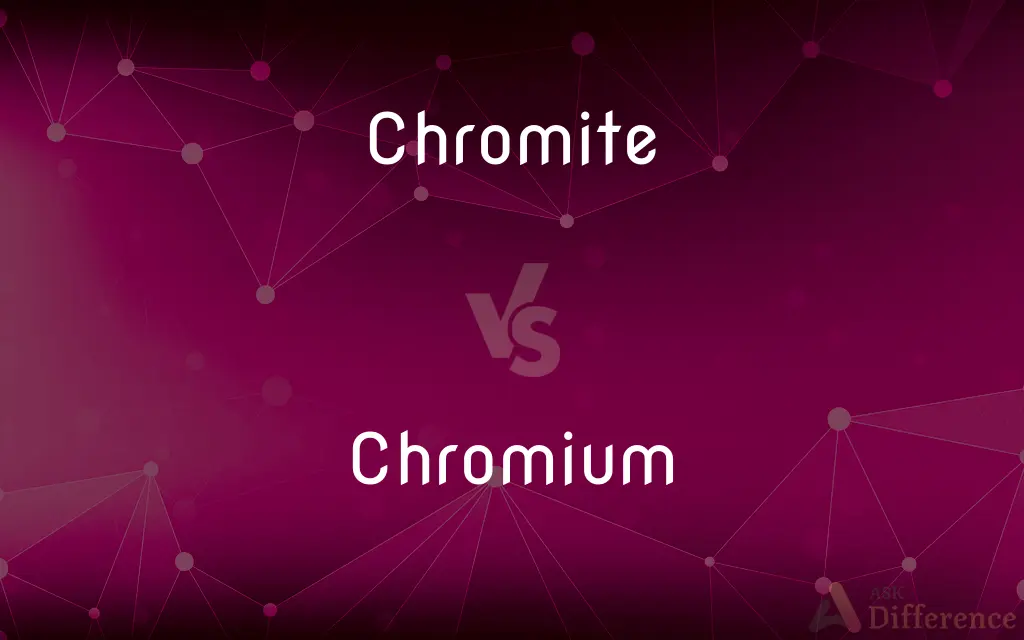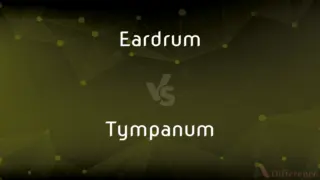Chromite vs. Chromium — What's the Difference?
By Fiza Rafique & Urooj Arif — Updated on April 9, 2024
Chromite is a naturally occurring mineral, while chromium is a chemical element extracted from chromite.

Difference Between Chromite and Chromium
Table of Contents
ADVERTISEMENT
Key Differences
Chromite is an iron chromium oxide mineral found in the Earth's mantle and is the primary source of the metal chromium. It is mined for its significant industrial value, especially in the production of stainless steel and other alloys. On the other hand, chromium is a lustrous, hard, and brittle chemical element with symbol Cr and atomic number 24. It is known for its high corrosion resistance and hardness, making it essential in manufacturing and various industrial applications.
While chromite itself is not used directly in most industrial applications, it is crucial as the primary ore from which chromium is extracted. Chromium, once extracted, is used extensively in electroplating, manufacturing of stainless steel, and in the production of green glass. Chromite, due to its high heat stability, is also used as a refractory material.
Chromite is extracted through mining and then processed to remove impurities and extract chromium. Chromium, however, is processed further through various chemical reactions to be used in different forms, including Chromium(III) and Chromium(VI), each having distinct properties and uses.
Environmental concerns differ significantly between chromite and chromium. Mining of chromite impacts ecosystems through habitat destruction and pollution. Chromium, especially in its hexavalent form, poses serious health risks to humans, including respiratory problems and cancer risk, necessitating careful handling and disposal.
The economic value of chromite is directly linked to its chromium content. The higher the chromium content in the ore, the more valuable it is. Chromium's value, on the other hand, is determined by its demand in various industrial applications, such as metallurgy, dyes, and wood preservation.
ADVERTISEMENT
Comparison Chart
Type
Mineral
Chemical Element
Composition
Iron chromium oxide (FeCr2O4)
Element with symbol Cr
Primary Use
Source of chromium
Manufacturing, electroplating
Environmental Impact
Habitat destruction, pollution
Toxicity, especially in hexavalent form
Economic Value
Based on chromium content in ore
Based on industrial demand
Compare with Definitions
Chromite
A dark brown to black mineral consisting of iron chromium oxide.
The company mined chromite, aiming to extract its valuable chromium content.
Chromium
A chemical element with symbol Cr and atomic number 24, known for its high corrosion resistance.
Chromium plating is used to enhance the durability of metal objects.
Chromite
The primary ore from which chromium is extracted.
Chromite deposits are essential for the production of stainless steel.
Chromium
Extracted from chromite through various industrial processes.
The facility processes chromite to produce pure chromium metal.
Chromite
Used in high-temperature applications due to its heat resistance.
Chromite is utilized in the manufacturing of refractory bricks.
Chromium
Exists in several oxidation states, with Chromium(III) and Chromium(VI) being the most common in industrial applications.
Chromium(VI) is used in dyes but poses environmental and health risks.
Chromite
Found in various geological settings, including layered intrusions and serpentine bodies.
The geologist identified the rock as chromite from its characteristic appearance.
Chromium
Essential in the manufacturing of dyes, paints, and tanning leather.
Chromium compounds add vibrant colors to paints and dyes.
Chromite
Mined in several countries, with significant deposits in South Africa and Kazakhstan.
The chromite mine contributed significantly to the region's economy.
Chromium
Used in stainless steel production for its anti-corrosive properties.
The addition of chromium gives stainless steel its rust-resistant qualities.
Chromite
Chromite is a crystalline mineral composed primarily of iron(II) oxide and chromium(III) oxide compounds. It can be represented by the chemical formula of FeCr2O4.
Chromium
Chromium is a chemical element with the symbol Cr and atomic number 24. It is the first element in group 6.
Chromite
A widely distributed black to brownish-black chromium ore, FeCr2O4.
Chromium
A lustrous, hard, steel-gray metallic element, resistant to tarnish and corrosion and found primarily in chromite. It is used in the hardening of steel alloys and the production of stainless steels, in corrosion-resistant decorative platings, and as a pigment in glass. Atomic number 24; atomic weight 51.996; melting point 1,907°C; boiling point 2,671°C; specific gravity 7.15; valence 2, 3, 6. See Periodic Table.
Chromite
(mineral) A dark brown mineral species with the formula FeCr2O4.
Chromium
A chemical element (symbol Cr) with an atomic number of 24: a steely-grey, lustrous, hard and brittle transition metal.
Chromite
Any member of the chromite-magnesiochromite series that is a mixed oxide of iron, magnesium and chromium with the formula (Fe,Mg)Cr2O4. It is a commercial source of chromium.
Chromium
A comparatively rare element occurring most abundantly in the mineral chromite. Atomic weight 52.5. Symbol Cr. When isolated it is a hard, brittle, grayish white metal, fusible with difficulty. Its chief commercial importance is for its compounds, as potassium chromate, lead chromate, etc., which are brilliantly colored and are used dyeing and calico printing. Called also chrome.
Chromite
A black submetallic mineral consisting of oxide of chromium and iron; - called also chromic iron.
Chromium
A hard brittle blue-white multivalent metallic element; resistant to corrosion and tarnishing
Chromite
A compound or salt of chromous hydroxide regarded as an acid.
Chromite
A brownish-black mineral; the major source of chromium
Common Curiosities
Why is chromite important?
Chromite is important as the primary ore from which chromium, a metal essential for many industrial applications, is extracted.
What is chromite?
Chromite is a mineral composed of iron chromium oxide, serving as the primary source of chromium.
What makes chromium valuable?
Chromium's value lies in its properties like corrosion resistance, hardness, and its role in manufacturing processes.
What are the health risks of chromium?
Exposure to high levels of chromium, particularly Chromium(VI), can cause respiratory problems and increase cancer risk.
How is chromium used in electroplating?
Chromium is used in electroplating to coat objects with a thin layer of chromium for corrosion resistance and aesthetic purposes.
Are there environmental concerns associated with chromite mining?
Yes, chromite mining can lead to habitat destruction and pollution.
What is the difference between Chromium(III) and Chromium(VI)?
Chromium(III) is a more stable, less toxic form of chromium, while Chromium(VI) is highly toxic and carcinogenic.
What are the main uses of chromium?
Chromium is used in stainless steel production, electroplating, and manufacturing dyes and paints.
Is chromite used for anything besides chromium extraction?
Yes, due to its heat stability, chromite is also used in making refractories.
How is chromium extracted from chromite?
Chromium is extracted from chromite through various chemical processes that separate the metal from other elements in the ore.
Can chromium be found in its pure form in nature?
No, chromium does not occur freely in nature but is extracted from chromite.
What role does chromium play in green glass production?
Chromium gives green glass its characteristic color.
How does chromium benefit stainless steel?
Chromium adds corrosion resistance, hardness, and brightness to stainless steel.
Where is chromite found?
Chromite is found in various parts of the world, with significant deposits in South Africa, Kazakhstan, and India.
What is the economic impact of chromium?
Chromium plays a significant role in the economy through its wide use in manufacturing, affecting industries like automotive, construction, and electronics.
Share Your Discovery

Previous Comparison
Eardrum vs. Tympanum
Next Comparison
Outrage vs. RageAuthor Spotlight
Written by
Fiza RafiqueFiza Rafique is a skilled content writer at AskDifference.com, where she meticulously refines and enhances written pieces. Drawing from her vast editorial expertise, Fiza ensures clarity, accuracy, and precision in every article. Passionate about language, she continually seeks to elevate the quality of content for readers worldwide.
Co-written by
Urooj ArifUrooj is a skilled content writer at Ask Difference, known for her exceptional ability to simplify complex topics into engaging and informative content. With a passion for research and a flair for clear, concise writing, she consistently delivers articles that resonate with our diverse audience.
















































